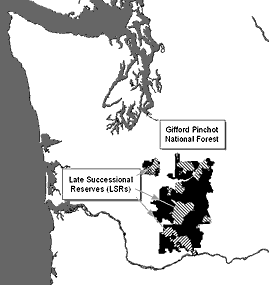
Map showing Western Washington and the Gifford Pinchot. Black areas are designated for logging, and hatched areas (LSRs) are designated for preservation. Old growth only exists in small pockets inside the LSRs. Map by David Jennings.
go to WASHINGTON FREE PRESS HOME (subscribe, contacts, archives, latest, etc.)
Sept/Oct 2000 issue (#47)
David Jennings, chair of the Olympia-based Gifford Pinchot Task Force, has a map he'd like you to see. It depicts nine isolated regions within the Gifford Pinchot National Forest, called "Late Successional Reserves" (LSRs). The LSRs have been put off-limits from logging under the Clinton Administration's Northwest Forest Plan.
On his map the nine Gifford Pinchot LSRs, selected to provide lasting ancient forest habitat for spotted owls and other species dependent on old growth trees, look kind of reassuring. Each LSR looks like its own green island of forest sanctuary. Then, with the punch of a button on his laptop, Jennings alters the map to display the areas within the LSRs that actually sustain functioning Old Growth ecosystems. Suddenly the broad islands of green disappear, and are replaced by a smattering of green flecks. "The big green islands were a mirage," Jennings announces. "This is a totally dysfunctional forest protection system."
With the approach of the Fall elections, Jennings and other environmental activists plan to draw attention to the failure of the Northwest Forest Plan to protect functioning Old Growth ecosystems. The campaign appears well timed, because old growth forests in the Northwest, which have been lately spared from logging by a series of successful lawsuits, are slated to return to the chopping block this winter with the expected implementation of the Northwest Forest Plan, which authorizes commercial logging on 5.5 million acres of forest within the range of the Northern Spotted Owl. Activists are hoping to bring public pressure to bear to reform the plan, and thereby better preserve the Northwest's ancient forests.
Jennings and his colleague Peter Nelson, of Seattle's Pacific Crest Biodiversity Project, are focusing their attention on the Gifford Pinchot (GP), the forested lowlands that blanket Southwest Washington between Mt. Rainer, Mt. St. Helens, Mt. Adams and Mt. Hood. Jennings and Nelson point out that, like the Northwest Forest Plan in general, the management plan for the GP doesn't preserve sufficient old growth, wildlands or roadless areas. They specifically contend that the plan for the GP not only authorizes the logging of ecologically critical small roadless areas, it ignores realities that render the forest's LSRs inadequate for their appointed task of preserving functioning ecosystems.
Jennings and Nelson point out that, for its part, the GP management plan authorizes the removal of 60 million board feet of timber each year. That's 30,000 logging trucks' worth. They emphasize that half of this logging volume will come from old growth, and that about one-fourth will occur in roadless areas within the GP. Jennings argues that with roads already permeating the GP like a well-developed system of veins and capillaries, the Forest Service should be expanding its protection of roadless areas, not logging them.
Jennings further points out that the few remaining old growth trees in the Northwest are not concentrated in specific locations, but are scattered throughout Northwest forests. Thus in protecting only the LSRs, the GP plan protects isolated areas dominated by younger trees at the expense of allowing the logging of tens of thousands of acres of old growth located elsewhere. Not only are the GP's LSRs predominantly composed of younger trees, they are scarred with clearcuts, dissected by roads and interspersed with meadows, all of which impair functioning ecosystems.
Stands in the LSRs are also impacted by "edge effect," a clearcut's degradation of forest habitat several hundred feet into the interior of adjacent stands. All of these impacts, Jennings says, dramatically reduce the capability of the LSRs to provide functioning habitat. Thus the sparse green flecks on Jennings' map.

Map showing Western Washington and the Gifford Pinchot. Black areas are designated for logging, and hatched areas (LSRs) are designated for preservation. Old growth only exists in small pockets inside the LSRs. Map by David Jennings. |
All of this is bad enough for the GP, but Jennings points out that the story gets worse on the millions of acres of state and private lands outside of Washington's national forests. On these lands, Washington State and federal agencies are authorizing increased old growth logging on the assumption that the Northwest and GP forest plans will shoulder the burden of preserving adequate amounts of ancient forest. "Current forest management practices are built on the misconception," Jennings says, "that the Northwest Forest Plan will provide adequate protection, when in fact it will not."
When Jennings displayed his maps contrasting the promise and the reality of the GP management plan at a recent forest policy teach-in in Seattle, they drew gasps from the audience. "Every time I see David's presentation," Peter Nelson said to the crowd at the teach-in, "my heart goes up into my throat."
Jennings and Nelson are hoping that their public education campaign, with its revelation of the stark ecological realities of the Northwest and GP Forest plans, will spur Congress and the Forest Service to adopt policies that, instead of creating green mirages, will preserve true functioning ecosystems in Northwest forests.
|
go to WASHINGTON FREE PRESS HOME |